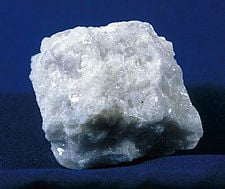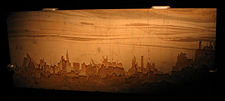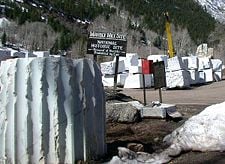Difference between revisions of "Marble" - New World Encyclopedia
(moved image) |
|||
| Line 1: | Line 1: | ||
:''For glass, metal, or ceramic toys, see [[marbles]].'' | :''For glass, metal, or ceramic toys, see [[marbles]].'' | ||
| − | [[Image:Wenuszmf.jpg|thumb|120px|right|Venus de Milo, | + | [[Image:Wenuszmf.jpg|thumb|120px|right|Venus de Milo, an ancient Greek statue made of marble.]] |
'''Marble''' is a [[metamorphic rock]]*, resulting from the metamorphism (transformation) of [[limestone]]. It is composed mostly of [[calcite]]*, a crystalline form of [[calcium carbonate]]* (CaCO<sub>3</sub>). It is used extensively for [[sculpture]], as a [[architecture|building]]* material, and for many other applications. The word 'marble' is colloquially used to refer to many other stones that are capable of taking a high polish. | '''Marble''' is a [[metamorphic rock]]*, resulting from the metamorphism (transformation) of [[limestone]]. It is composed mostly of [[calcite]]*, a crystalline form of [[calcium carbonate]]* (CaCO<sub>3</sub>). It is used extensively for [[sculpture]], as a [[architecture|building]]* material, and for many other applications. The word 'marble' is colloquially used to refer to many other stones that are capable of taking a high polish. | ||
| Line 6: | Line 6: | ||
"Faux marble" (or faux marbling) is a wall-painting technique that imitates the color patterns of real marble (not to be confused with paper marbling). Marble dust can be combined with cement or synthetic resins to make reconstituted or "cultured marble." | "Faux marble" (or faux marbling) is a wall-painting technique that imitates the color patterns of real marble (not to be confused with paper marbling). Marble dust can be combined with cement or synthetic resins to make reconstituted or "cultured marble." | ||
| − | + | ==Etymology== | |
| + | |||
| + | The word "marble" derives from the [[Greek language|Greek]] ''marmaros'', meaning "shining stone." This stem is also the basis for the English adjective "marmoreal," which refers to something that is like marble, or someone who is aloof like a marble statue. | ||
| + | |||
| + | == Cultural associations == | ||
| + | |||
| + | As the favorite medium for [[Greece|Greek]] and [[Roman Empire|Roman]] sculptors and architects, marble has become a cultural symbol of tradition and refined taste. Its extremely varied and colorful patterns make it a favorite decorative material, and are often imitated, such as in background patterns for computer displays. | ||
| + | |||
| + | In folklore, marble is associated with the astrological sign of [[Gemini]]*. Pure white marble is a symbol of purity and immortality. It is also considered an ensurer of success in education. | ||
==Origins== | ==Origins== | ||
[[Image:MarbleUSGOV.jpg|225px|thumb|left|Marble.]] | [[Image:MarbleUSGOV.jpg|225px|thumb|left|Marble.]] | ||
| − | Marble is a [[metamorphic rock]]*, resulting from the [[metamorphism]] (transformation) of [[sedimentary rock|sedimentary]]* carbonate rocks—either [[limestone]] (composed mainly of the mineral calcite) or [[dolomite]] rock (composed mainly of the mineral dolomite). The metamorphic process, which takes place at high temperatures and pressures, causes a complete recrystallization of the original rock into an interlocking mosaic of calcite or dolomite [[crystal]]s. Calcite consists of calcium carbonate (CaCO<sub>3</sub>), and dolomite, of calcium magnesium carbonate (CaMg(CO<sub>3</sub>)<sub>2</sub>). The temperatures and pressures necessary to form marble usually destroy any [[fossil]]s and sedimentary textures present in the original rock. | + | Marble is a [[metamorphic rock]]*, resulting from the [[metamorphism]]* (transformation) of [[sedimentary rock|sedimentary]]* carbonate rocks—either [[limestone]] (composed mainly of the mineral calcite) or [[dolomite]] rock (composed mainly of the mineral dolomite). The metamorphic process, which takes place at high temperatures and pressures, causes a complete recrystallization of the original rock into an interlocking mosaic of calcite or dolomite [[crystal]]s. Calcite consists of calcium carbonate (CaCO<sub>3</sub>), and dolomite, of calcium magnesium carbonate (CaMg(CO<sub>3</sub>)<sub>2</sub>). The temperatures and pressures necessary to form marble usually destroy any [[fossil]]s and sedimentary textures present in the original rock. |
Pure white marble is the result of metamorphism of very pure limestone. The characteristic swirls and veins of many colored marble varieties are usually due to the presence of minor amounts of other minerals such as [[clay]], [[silt]]*, [[sand]], iron oxides, or [[chert]]*, which were originally present as grains or layers in the limestone. These various mineral "impurities" were mobilized and recrystallized by the intense pressure and heat of the metamorphic process. | Pure white marble is the result of metamorphism of very pure limestone. The characteristic swirls and veins of many colored marble varieties are usually due to the presence of minor amounts of other minerals such as [[clay]], [[silt]]*, [[sand]], iron oxides, or [[chert]]*, which were originally present as grains or layers in the limestone. These various mineral "impurities" were mobilized and recrystallized by the intense pressure and heat of the metamorphic process. | ||
| Line 32: | Line 40: | ||
White marbles, like Carrara, have been prized for [[marble sculpture|sculpture]] since classical times. This preference has to do with its softness, homogeneity, and a relative resistance to shattering. Also, based on the low index of refraction of calcite, light can penetrate several millimeters into the stone before being scattered out, resulting in the characteristic waxy look that gives "life" to marble sculptures of the human body. | White marbles, like Carrara, have been prized for [[marble sculpture|sculpture]] since classical times. This preference has to do with its softness, homogeneity, and a relative resistance to shattering. Also, based on the low index of refraction of calcite, light can penetrate several millimeters into the stone before being scattered out, resulting in the characteristic waxy look that gives "life" to marble sculptures of the human body. | ||
| − | + | Places named after the stone include Marble Hill in Manhattan, New York; the [[Sea of Marmara]]*; [[India]]'s Marble Rocks; the towns of Marble in Minnesota and Colorado; and Marble Arch in [[London]]. The Elgin Marbles are marble sculptures from the [[Parthenon]]* (ancient Greek temple) that are on display in the British Museum. | |
| − | |||
| − | |||
| − | == | + | ==Uses of marble== |
| − | Colorless marbles are a very pure source of [[calcium carbonate]], which is used in a wide variety of industries. | + | Colorless marbles are a very pure source of [[calcium carbonate]]*, which is used in a wide variety of industries. Finely ground marble powder is a component in [[paint]]s, [[toothpaste]], and [[plastic]]s. Calcium carbonate can also be reduced under high heat to [[calcium oxide]] (also known as "lime"), which has many applications, including being a primary component of most cements. |
| − | == | + | == Construction marble == |
| − | |||
| − | |||
| − | |||
| − | |||
| − | |||
| − | |||
| − | In | + | In the [[construction]] trade, the term "marble" is used for any massive, crystalline, calcitic rock (and some non-calcitic rocks) useful as building stone. For example, [[Tennessee Marble]]* is really a massive, fossil-rich dolomite rock of the [[Ordovician]] era. Its color ranges from gray to pink to maroon, and it is called the Holston formation by [[geology|geologists]]. |
==See also== | ==See also== | ||
*[[list of minerals]] | *[[list of minerals]] | ||
| − | |||
*[[limestone]] | *[[limestone]] | ||
| − | |||
*[[alabaster]] | *[[alabaster]] | ||
*[[granite]] | *[[granite]] | ||
| − | |||
*[[marble sculpture]] | *[[marble sculpture]] | ||
*[[marquetry]] — inlaying with marble and other stones. | *[[marquetry]] — inlaying with marble and other stones. | ||
Revision as of 19:06, 20 August 2006
- For glass, metal, or ceramic toys, see marbles.
Marble is a metamorphic rock, resulting from the metamorphism (transformation) of limestone. It is composed mostly of calcite, a crystalline form of calcium carbonate (CaCO3). It is used extensively for sculpture, as a building material, and for many other applications. The word 'marble' is colloquially used to refer to many other stones that are capable of taking a high polish.
"Faux marble" (or faux marbling) is a wall-painting technique that imitates the color patterns of real marble (not to be confused with paper marbling). Marble dust can be combined with cement or synthetic resins to make reconstituted or "cultured marble."
Etymology
The word "marble" derives from the Greek marmaros, meaning "shining stone." This stem is also the basis for the English adjective "marmoreal," which refers to something that is like marble, or someone who is aloof like a marble statue.
Cultural associations
As the favorite medium for Greek and Roman sculptors and architects, marble has become a cultural symbol of tradition and refined taste. Its extremely varied and colorful patterns make it a favorite decorative material, and are often imitated, such as in background patterns for computer displays.
In folklore, marble is associated with the astrological sign of Gemini. Pure white marble is a symbol of purity and immortality. It is also considered an ensurer of success in education.
Origins
Marble is a metamorphic rock, resulting from the metamorphism (transformation) of sedimentary carbonate rocks—either limestone (composed mainly of the mineral calcite) or dolomite rock (composed mainly of the mineral dolomite). The metamorphic process, which takes place at high temperatures and pressures, causes a complete recrystallization of the original rock into an interlocking mosaic of calcite or dolomite crystals. Calcite consists of calcium carbonate (CaCO3), and dolomite, of calcium magnesium carbonate (CaMg(CO3)2). The temperatures and pressures necessary to form marble usually destroy any fossils and sedimentary textures present in the original rock.
Pure white marble is the result of metamorphism of very pure limestone. The characteristic swirls and veins of many colored marble varieties are usually due to the presence of minor amounts of other minerals such as clay, silt, sand, iron oxides, or chert, which were originally present as grains or layers in the limestone. These various mineral "impurities" were mobilized and recrystallized by the intense pressure and heat of the metamorphic process.
Kinds of marble
Some historically important kinds of marble, named after the locations of their quarries, include:
- Paros and Penteli from Greece
- Carrara from Italy
- Proconnesus from Turkey
- Macael from Spain
- Makrana from India
- Danby from Vermont, United States
- Yule from Colorado, United States
White marbles, like Carrara, have been prized for sculpture since classical times. This preference has to do with its softness, homogeneity, and a relative resistance to shattering. Also, based on the low index of refraction of calcite, light can penetrate several millimeters into the stone before being scattered out, resulting in the characteristic waxy look that gives "life" to marble sculptures of the human body.
Places named after the stone include Marble Hill in Manhattan, New York; the Sea of Marmara; India's Marble Rocks; the towns of Marble in Minnesota and Colorado; and Marble Arch in London. The Elgin Marbles are marble sculptures from the Parthenon (ancient Greek temple) that are on display in the British Museum.
Uses of marble
Colorless marbles are a very pure source of calcium carbonate, which is used in a wide variety of industries. Finely ground marble powder is a component in paints, toothpaste, and plastics. Calcium carbonate can also be reduced under high heat to calcium oxide (also known as "lime"), which has many applications, including being a primary component of most cements.
Construction marble
In the construction trade, the term "marble" is used for any massive, crystalline, calcitic rock (and some non-calcitic rocks) useful as building stone. For example, Tennessee Marble is really a massive, fossil-rich dolomite rock of the Ordovician era. Its color ranges from gray to pink to maroon, and it is called the Holston formation by geologists.
See also
- list of minerals
- limestone
- alabaster
- granite
- marble sculpture
- marquetry — inlaying with marble and other stones.
- faux marbling — painting surfaces to look like marble.
- scagliola — imitating marble with plasterwork.
- cultured marble — marble powder with a binder.
- paper marbling
- Stones of India Marble
External links
- Tips for cleaning marble
- Calcite, Limestone and Marble by Kelly Snyder and Peter Russel
- How to engrave marble with laser.
- Marble Institute of America, a trade organization.
- Learning to carve by Marc Levoy.
Credits
New World Encyclopedia writers and editors rewrote and completed the Wikipedia article in accordance with New World Encyclopedia standards. This article abides by terms of the Creative Commons CC-by-sa 3.0 License (CC-by-sa), which may be used and disseminated with proper attribution. Credit is due under the terms of this license that can reference both the New World Encyclopedia contributors and the selfless volunteer contributors of the Wikimedia Foundation. To cite this article click here for a list of acceptable citing formats.The history of earlier contributions by wikipedians is accessible to researchers here:
The history of this article since it was imported to New World Encyclopedia:
Note: Some restrictions may apply to use of individual images which are separately licensed.



